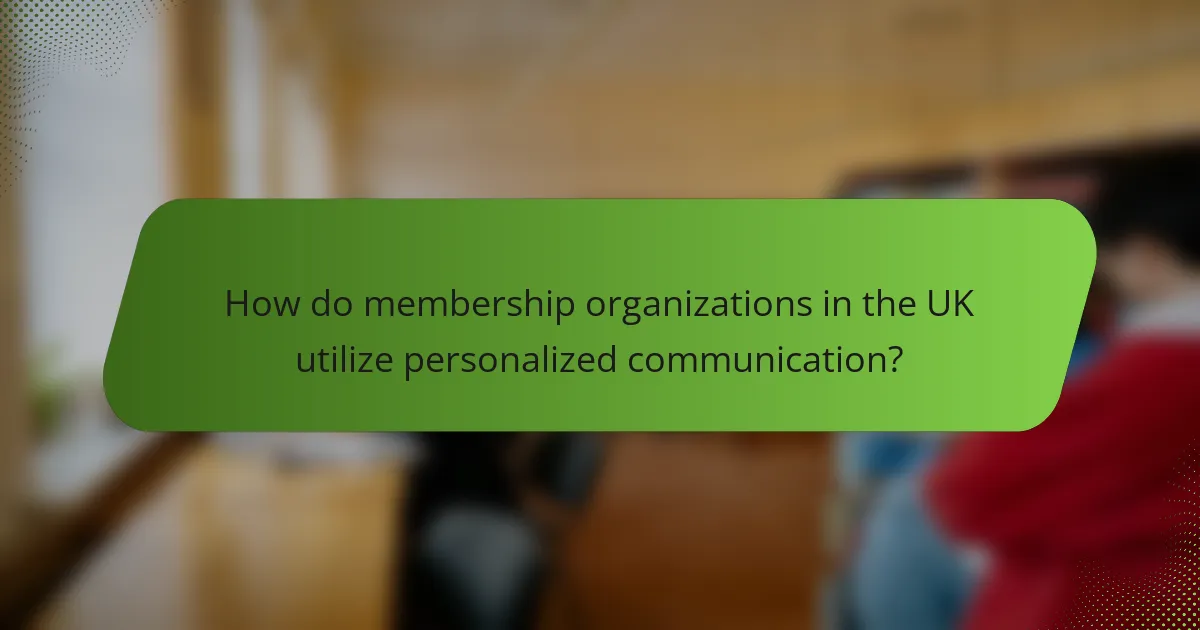Personalized communication plays a crucial role in enhancing membership experiences by ensuring that interactions are relevant and engaging. By customizing messages to align with individual preferences, organizations can cultivate a deeper sense of belonging and boost overall member satisfaction, ultimately fostering loyalty.

How does personalized communication enhance membership experiences?
Personalized communication significantly enhances membership experiences by making interactions more relevant and engaging for members. By tailoring messages and content to individual preferences, organizations can foster a sense of belonging and increase overall satisfaction.
Increased member engagement
Personalized communication leads to higher member engagement by delivering content that resonates with individual interests. When members receive tailored messages, they are more likely to participate in activities, respond to surveys, and engage with the community. For example, sending personalized event invitations based on past attendance can boost participation rates significantly.
To enhance engagement, organizations should utilize data analytics to understand member preferences and behaviors. Regularly updating communication strategies based on feedback can further improve engagement levels.
Improved retention rates
Effective personalized communication can improve retention rates by making members feel valued and understood. When members receive relevant information and offers, they are more likely to renew their memberships. For instance, sending personalized renewal reminders that highlight the benefits a member has enjoyed can encourage them to continue their membership.
Organizations should monitor retention metrics and adjust their communication strategies accordingly. Implementing loyalty programs that reward long-term members can also reinforce retention efforts.
Tailored content delivery
Tailored content delivery ensures that members receive information that is pertinent to their interests and needs. By segmenting audiences based on demographics or behavior, organizations can send targeted newsletters, updates, and resources that align with member preferences. This approach not only keeps members informed but also enhances their overall experience.
Utilizing automated marketing tools can streamline the process of delivering personalized content. Regularly reviewing and updating content strategies based on member feedback can further refine the effectiveness of tailored delivery.
Stronger emotional connections
Personalized communication fosters stronger emotional connections between members and the organization. When members feel recognized and appreciated through customized messages, they are more likely to develop loyalty and advocacy for the brand. For example, sending personalized birthday greetings or milestone acknowledgments can create a positive emotional impact.
To strengthen these connections, organizations should focus on building a narrative that resonates with their members. Sharing success stories or testimonials that reflect member experiences can also enhance emotional ties and community spirit.

What are the best practices for personalized communication in memberships?
Effective personalized communication in memberships hinges on understanding member preferences and behaviors. By leveraging data and technology, organizations can tailor their messaging to enhance member experiences and foster loyalty.
Data-driven segmentation
Data-driven segmentation involves categorizing members based on shared characteristics, such as demographics, interests, and engagement levels. This process allows organizations to create targeted communications that resonate with specific groups, increasing the likelihood of engagement.
To implement effective segmentation, collect data through surveys, membership applications, and interaction history. Regularly update these segments to reflect changing member preferences and behaviors, ensuring your communication remains relevant.
Utilizing CRM tools like Salesforce
CRM tools, such as Salesforce, are essential for managing member relationships and personalizing communication. These platforms enable organizations to track member interactions, preferences, and feedback, facilitating tailored messaging that addresses individual needs.
When using CRM tools, ensure that your team is trained to input and analyze data effectively. This will help in crafting personalized messages that can enhance member satisfaction and retention rates.
Automated messaging strategies
Automated messaging strategies streamline communication by sending personalized messages based on member behavior and preferences. For instance, welcome emails, renewal reminders, and targeted promotions can be automated to ensure timely and relevant outreach.
To maximize the effectiveness of automated messaging, segment your audience and customize the content for each group. Monitor engagement metrics to refine your strategies and avoid common pitfalls, such as sending too many messages or irrelevant content that may lead to member disengagement.

How can organizations measure the impact of personalized communication?
Organizations can measure the impact of personalized communication through various methods that assess member satisfaction, engagement, and retention. By utilizing tools like feedback surveys, analyzing engagement metrics, and tracking retention rates, organizations can gain valuable insights into how personalized messaging influences member experiences and loyalty.
Member feedback surveys
Member feedback surveys are a direct way to gauge the effectiveness of personalized communication. These surveys can include questions about members’ perceptions of the relevance and value of the messages they receive. Organizations should aim for a response rate of at least 20-30% to ensure the feedback is representative.
When designing surveys, consider using a mix of quantitative and qualitative questions. For example, ask members to rate their satisfaction on a scale from 1 to 10 and provide space for open-ended comments. This approach can reveal specific areas for improvement.
Engagement metrics analysis
Engagement metrics analysis involves tracking how members interact with personalized communications. Key metrics include open rates, click-through rates, and time spent on content. A higher engagement rate often indicates that the communication resonates with members.
Organizations should benchmark these metrics against industry standards to assess performance. For instance, an email open rate of 20-30% is generally considered good in many sectors. Regularly reviewing these metrics helps identify trends and adjust strategies accordingly.
Retention rate tracking
Retention rate tracking measures how well personalized communication contributes to keeping members engaged over time. A high retention rate suggests that members find value in the personalized interactions they receive. Organizations can calculate retention rates by comparing the number of active members at the beginning and end of a specific period.
To enhance retention, organizations should analyze the correlation between communication efforts and member churn. For example, if retention improves after implementing personalized messaging strategies, it may indicate their effectiveness. Regularly monitoring these rates can help in refining communication tactics to boost loyalty.

What technologies support personalized communication in membership models?
Technologies that enhance personalized communication in membership models include email marketing platforms, personalization engines, and analytics tools. These technologies help organizations tailor their messages and offers to individual members, boosting engagement and loyalty.
Email marketing platforms like Mailchimp
Email marketing platforms such as Mailchimp enable organizations to segment their member lists and send targeted communications. By using member data, these platforms allow for personalized content that resonates with specific interests and behaviors.
To maximize effectiveness, consider A/B testing subject lines and content to see what drives higher open and click-through rates. Regularly updating your email lists and maintaining compliance with regulations like GDPR is also crucial.
Personalization engines like Dynamic Yield
Personalization engines like Dynamic Yield leverage machine learning to deliver customized experiences across various touchpoints. These tools analyze user behavior to recommend products, content, or services that align with individual preferences.
When implementing a personalization engine, ensure that you have sufficient data to inform the algorithms. Start with a few key segments and expand as you gather more insights about member interactions.
Analytics tools such as Google Analytics
Analytics tools like Google Analytics provide valuable insights into member behavior and engagement patterns. By tracking metrics such as page views, session duration, and conversion rates, organizations can better understand what content resonates with their members.
Utilize these insights to refine your communication strategies. Regularly review your analytics to identify trends and adjust your approach accordingly, ensuring that your messaging remains relevant and effective.

What challenges do organizations face in implementing personalized communication?
Organizations encounter several challenges when implementing personalized communication, including data privacy concerns, resource allocation for technology, and maintaining message relevance. These obstacles can hinder the effectiveness of personalized strategies and impact customer loyalty.
Data privacy concerns
Data privacy is a significant challenge for organizations aiming to personalize communication. With regulations like GDPR in Europe and CCPA in California, companies must ensure they collect and use customer data responsibly. Failing to comply can lead to hefty fines and damage to reputation.
To address these concerns, organizations should implement transparent data practices. This includes obtaining explicit consent from customers and providing clear information on how their data will be used. Regular audits and updates to privacy policies can also help maintain compliance.
Resource allocation for technology
Implementing personalized communication requires investment in technology, which can be a barrier for many organizations. Businesses need to allocate resources for customer relationship management (CRM) systems, data analytics tools, and marketing automation platforms to effectively tailor their messaging.
Organizations should evaluate their current technology stack and identify gaps that need to be filled. Prioritizing investments based on potential return on investment (ROI) can help ensure that resources are used effectively. Collaborating with technology partners may also ease the burden of resource allocation.
Maintaining message relevance
Keeping messages relevant to each customer is crucial for successful personalized communication. Organizations must continuously analyze customer data to understand preferences and behaviors, ensuring that the content resonates with the audience.
To maintain relevance, companies should segment their audience based on various criteria, such as purchase history or engagement levels. Regularly updating content and utilizing feedback mechanisms can help refine messaging strategies and enhance customer loyalty.

How do membership organizations in the UK utilize personalized communication?
Membership organizations in the UK leverage personalized communication to enhance member engagement and loyalty. By tailoring messages and interactions based on individual member preferences and behaviors, these organizations create meaningful experiences that foster long-term relationships.
Benefits of Personalized Communication
Personalized communication offers several advantages for membership organizations. It increases member satisfaction by addressing individual needs and preferences, leading to higher retention rates. Additionally, personalized interactions can enhance the perceived value of membership, encouraging members to engage more actively.
For example, organizations might send tailored newsletters featuring content relevant to a member’s interests or offer exclusive discounts based on previous purchases. This targeted approach not only improves the member experience but also drives organizational goals such as increased participation and revenue.
Strategies for Implementing Personalization
To effectively implement personalized communication, organizations should start by collecting relevant data on their members. This can include demographic information, preferences, and past interactions. Utilizing customer relationship management (CRM) systems can help streamline this process and make data easily accessible.
Once data is gathered, organizations can segment their members into distinct groups based on shared characteristics. This allows for more targeted messaging, ensuring that communications resonate with each segment. Regularly updating this data is crucial to maintain relevance and effectiveness.
Common Challenges and Solutions
While personalized communication is beneficial, it comes with challenges. One common issue is data privacy concerns, as members may be wary of how their information is used. Organizations must comply with regulations like the UK General Data Protection Regulation (GDPR) to ensure transparency and build trust.
Another challenge is the potential for over-communication, which can lead to member fatigue. To avoid this, organizations should establish a balanced communication strategy that respects members’ preferences for frequency and channels. Regular feedback from members can help refine these strategies and improve overall effectiveness.
